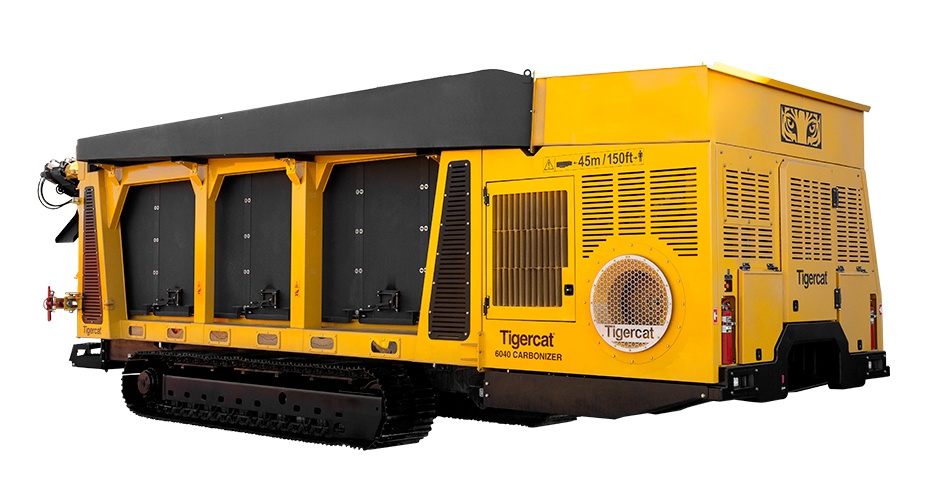New From Tigercat: 6040 Carbonizer
Tigercat Industries has announced the official release of its 6040 carbonizer—which replaces the 6050 carbonator that Tigercat marketed for a brief time after acquiring the product through the purchase of ROI in 2019. The mobile onsite wood conversion system is once again available after a comprehensive, ground-up redesign.
The 6040 is one of the most environmentally friendly wood debris reduction and conversion systems available on the market. The machine inputs woody debris and produces a high-quality organic carbon with up to 90% material reduction. It is an ideal solution for converting unwanted logging and agriculture residue into a useful, high grade organic carbon that can be left onsite as a soil additive or marketed for many different commercial uses. The process captures 20 to 30% of the available carbon in the feedstock and sequesters it for thousands of years, furthering the goals of greenhouse gas reduction. The innovative conversion process operates at high throughput levels and produces very low emissions because the gasses are combusted in the controlled combustion zone.
The 6040 redesign addresses performance related issues experienced in the original design and represents the knowledge of the applications that Tigercat engineers and field support personnel have gained over the past five years. The grates in the carbonizing chamber are now made up of seven different sections that can be rotated 180° to balance wear and extend life. Individual sections can be replaced as required. The undercarriage, auger trough, and conveyor system are all bolt-on sections to the main carbonizing chamber frame. Everything can be separated for service and replacement if required. The modular bolt-on design also allows for differing expansion rates of these major components.
The replaceable thermal-ceramic panel seal plate design has been improved, reducing panel wear. The composition of the panels has been altered to decrease back-face temperature while storing and utilizing more of the heat energy produced during the carbonizing process. This provides a more stable and sustained temperature within the carbonizing chamber. The result is increased efficiency, higher infeed rates, reduced emissions, and a greater yield of higher quality organic carbon.
The auger trough is designed for minimal air leakage, assisting with under-air efficiency, further defining the secondary combustion zone, while reducing hotspots that could form from an inefficient base pressure or vacuum. Unlike the 6050, the auger trough, where the quenching process takes place, is entirely sealed. Once the organic carbon drops through the grates, it is fully quenched by the water bath. An onboard hydraulic water supply pump and integrated automatic water level control system reduces water consumption by about 50% compared with the 6050. Automated water fill, level control, and water retention provides the operator a window of time to replenish the water supply if required.
The adjustable conveyor simplifies handling and management of the organic carbon product. It pivots 105° from side to side and can be raised or lowered. The conveyor easily folds for transport and does not have to be detached from the machine frame.
Temperature control sensors are located throughout the machine. This, coupled with the Tigercat designed operating software and telematics system, improves data access and customer support. The 6040 development also emphasized parts commonality among other Tigercat products including pumps, motors, valves and filters, simplifying parts inventory management at the dealer and end user level.
The overall machine weight has been reduced from 43 550 kg (96,000 lb.) to 37 650 kg (83,000 lb.). Extended track frames improve load distribution on the trailer and reduce soil compaction on the ground.
Latest news
Astec, Bejac Announce Distribution Agreement
Astec has announced Bejac Corp., a heavy equipment dealer with 10 locations, will represent the Peterson line of forestry and environmental recycling equipment in California and Arizona. Bejac, founded in 1953 operated as an underground pipeline contracting business until 1985 when the company pivoted to the heavy, specialty equipment sector…
Valmet To Convert Coal-Fired Boiler In Finland To Pellet-Fired
Valmet will be converting Helen Ltd.’s coal-fired district heat boiler to bubbling fluidized bed (BFB) combustion to enable wood pellet firing at the Salmisaari ‘A’ power plant in Helsinki, Finland. The conversion promotes the company’s goal of phasing out coal, while at the same time strengthening the construction of a sustainable energy system…
Enviva Announces First Quarter Setback
Enviva, the world’s largest producer of industrial wood pellets, released its quarterly report in early May, and it rippled through the wood-to-energy ranks. “The plans and initiatives underway to improve productivity and costs across Enviva’s current asset platform continue to fall behind expectations,” commented John Keppler, Executive Chairman of the board…
Dieffenbacher Names New Energy Unit Director
Wolfgang Lashofer has been appointed as the new Managing Director of Dieffenbacher Energy GmbH, which was formed at the beginning of the year following the acquisition of BERTSCHenergy, based in Bludenz, Western Austria. As Managing Director of Dieffenbacher Energy, Lashofer takes over the management of the newly established Energy Business Unit…
Find Us On Social
Subscribe to Our Newsletter
Wood Bioenergy News Online hits the inboxes of subscribers in the wood-to-energy sectors.
Subscribe/Renew
Wood Bioenergy is published and delivered worldwide 6 times per year. Free to qualified readers in the U.S. Subscribers outside the U.S. are asked to pay a small fee.
Advertise
Complete the online form so we can direct you to the appropriate Sales Representative.

